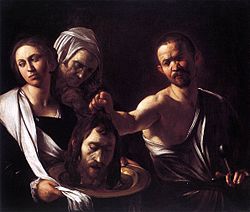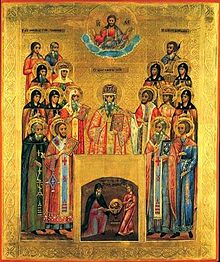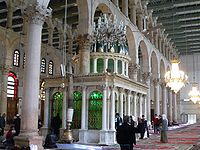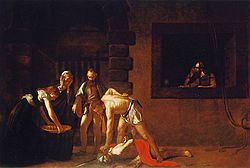- Beheading of St. John the Baptist
-
This article is about the biblical event and the liturgical commemoration of it. For the Caravaggio painting, see The Beheading of Saint John the Baptist (Caravaggio).
The Beheading of Saint John the Baptist (alternate names: Decollation of Saint John the Baptist and Beheading of the Forerunner) is a holy day observed by various Christian churches which follow liturgical traditions. The day commemorates the martyrdom of Saint John the Baptist.
Contents
Accounts
The biblical account portrays the beheading of Saint John the Baptist by Herod Antipas.[1] According to the Synoptic Gospels, Herod had imprisoned John because he reproved Herod for divorcing his wife (Phasaelis), and unlawfully taking Herodias, the wife of his brother Herod Philip I. On Herod's birthday, Herodias' daughter (traditionally named Salome) danced before the king and his guests. Her dancing pleased Herod so much that in his drunkenness he promised to give her anything she desired, up to half of his kingdom. When the daughter asked her mother what she should request, she was told to ask for the head of John the Baptist on a platter. Although Herod was appalled by the request, he reluctantly agreed and had John executed in the prison.
The Jewish historian Flavius Josephus also relates in his Antiquities of the Jews that Herod killed John, stating that he did so, "lest the great influence John had over the people might put it into his [John's] power and inclination to raise a rebellion, (for they seemed ready to do any thing he should advise), [so Herod] thought it best [to put] him to death." He further states that many of the Jews believed that the military disaster which fell upon Herod at the hands of Aretas his father-in-law (Phasaelis' father), was God's punishment for his unrighteous behavior.[2]
Feast day
The liturgical commemoration of the Beheading of St. John the Baptist is almost as old as that commemorating his Nativity, which is one of the oldest feasts, if not the oldest feast, introduced into both the Eastern and Western liturgies to honor a saint.
The Roman Catholic Church celebrates the feast on August 29, as does The Lutheran Church and The Church of England including many other national provinces of the Anglican Communion.
The Eastern Orthodox and Byzantine Catholic churches also celebrate this feast on August 29. This date in the Julian Calendar, used by the Russian, Macedonian and Serbian Orthodox Churches, corresponds in the present century to 11 September in the Gregorian Calendar. The day is always observed as a day of strict fasting. In some Orthodox cultures pious people will not eat food from a flat plate, use a knife, or eat food that is round in shape on this day.
The Armenian Apostolic Church celebrates the Decollation of St. John on Saturday of Easter Week.
The Syriac Orthodox, Indian Orthodox, and Syro-Malankara Catholic Churches commemorate the martyrdom on January 7.
Related feasts
There are two other related feasts observed by Eastern Christians:
- First and Second Finding of the Head of St. John the Baptist (February 24). According to church tradition after the execution of John the Baptist, his disciples buried his body at Sebaste, but Herodius[clarification needed] took his severed head and buried it in a dung heap. Later, Saint Joanna, who was married to Herod's steward,[3] secretly took his head and buried it on the Mount of Olives, where it remained hidden for centuries.
- The First Finding occurred in the fourth century. The property on the Mount of Olives where the head was buried eventually passed into the possession of a government official who became a monk with the name of Innocent. He built a church and a monastic cell there. When he started to dig the foundation, the vessel with the head of John the Baptist was uncovered. But fearful that the relic might be abused by unbelievers, he hid it again in the same place it had been found. Upon his death the church fell into ruin and was destroyed.
- The Second Finding occurred in the year 452. During the days of Constantine the Great, two monks on a pilgrimage to Jerusalem reportedly saw visions of John the Baptist, who revealed to them the location of his head. They uncovered the relic, placed it in a sack and proceeded home. Along the way they encountered an unnamed potter and gave him the bag to carry, not telling him what it was. The Forerunner appeared to him and ordered him to flee from the careless and lazy monks, with what he held in his hands. He did so and took the head home with him. Before his death he placed it in a container and gave it to his sister. After some time, a hieromonk by the name of Eustathius, an Arian, came into possession of it, using it to attract followers to his teaching. He buried the head in a cave, near Emesa. Eventually, a monastery was built at that place. In the year 452 St John the Baptist appeared to Archimandrite Marcellus of this monastery, and indicated where his head was hidden in a water jar buried in the earth. The relic was brought into the city of Emesa, and was later transferred to Constantinople.
- Third Finding of the Head of St. John the Baptist (May 25). The head was transferred to Comana of Cappadocia during a period of Muslim raids (about 820) and it was hidden in the ground during a period of iconoclastic persecution. When the veneration of icons was restored in 850, Patriarch Ignatius of Constantinople (847-857) saw in a vision the place where the head of St John had been hidden. The patriarch communicated this to the emperor Michael III, who sent a delegation to Comana, where the head was found. Afterwards the head was again transferred to Constantinople, and here on May 25 it was placed in a church at the court.
Relics
According to ancient tradition, the burial-place of John the Baptist was at Sebastia near modern-day Nablus in the West Bank, and mention is made of his relics being honored there around the middle of the fourth century. The historians Rufinus and Theodoretus record that the shrine was desecrated under Julian the Apostate around 362, the bones being partly burned. A portion of the rescued relics were carried to Jerusalem, then to Alexandria, where on 27 May 395, they were laid in the basilica that was newly dedicated to the Forerunner on the former site of the temple of Serapis. The tomb at Sebaste continued, nevertheless, to be visited by pious pilgrims, and St. Jerome bears witness to miracles being worked there. Today, the tomb is housed in the Nabi Yahya Mosque ("John the Baptist Mosque").
What became of the head of John the Baptist is difficult to determine. Nicephorus[4] and Symeon Metaphrastes say that Herodias had it buried in the fortress of Machaerus (in accordance with Josephus). Other writers say that it was interred in Herod's palace at Jerusalem; there it was found during the reign of Constantine, and thence secretly taken to Emesa, in Phoenicia, where it was concealed, the place remaining unknown for years, until it was manifested by revelation in 453.
Over the centuries, there have been many discrepancies in the various legends and claimed relics throughout the Christian world. Several different locations claim to possess the severed head of John the Baptist. Among the various claimants are:[5]
- Muslim tradition maintains that the head of John the Baptist was interred in the Umayyad Mosque in Damascus. Pope John Paul II visited the tomb of John the Baptist at the Umayyad Mosque during his visit to Syria in April, 2001.
- In medieval times it was rumored that the Knights Templar had possession of the head, and multiple records from their Inquisition in the early 14th century make reference to some form of head veneration.[6]
- Some Christians believe that the head on display in San Silvestro in Capite in Rome is that of John the Baptist.
- Amiens Cathedral claims the head as a relic brought from Constantinople by Wallon de Sarton as he was returning from the Fourth Crusade.
- In 1881 The New York Times claimed that the inmates of two rival French monasteries[which?][when?] used to exhibit, the one the skull of John the Baptist 'when he was a boy', the other his cranium 'after he had become a man'.[7]
- It is believed that a piece of his skull is held at the Romanian skete Prodromos on Mount Athos.
- A reliquary at The Residenz in Munich, Germany is labeled as containing the skull of John the Baptist.[8]
Numerous other relics of John the Baptist are also believed to exist, including the following:
- According to tradition, Luke the Evangelist went to the city of Sebaste, from which he took the right hand of the Forerunner (the hand that baptized Jesus) and brought it to Antioch, his home city, where it performed miracles. It is reported that the relic would be brought out and shown to the faithful on the Feast of the Exaltation of the Cross (September 14). If the fingers of the hand were open, it was interpreted as a sign of a bountiful year, if the hand was closed it would be a poor harvest (September 1 was the beginning of the liturgical year and the harvest season).
- On January 7, the Orthodox Church celebrates the Feast of the Transfer of the Right Hand of the Holy Forerunner from Antioch to Constantinople in 956 and the Miracle of Saint John the Forerunner against the Hagarines at Chios.
- In 1263 during the Sack of Constantinople by the Crusaders, the Frankish emperor Baldwin gave one bone from the wrist of Saint John the Baptist to Ottonus de Cichon, who in turn gave it to a Cistercian abbey in France.
- It is said John the Baptist's arm and a piece of his skull can be found at the Topkapı Palace in Istanbul, Turkey.
- In the year 1484 the right hand of the Forerunner was given by the son of Sultan Bayezid II to the Knights Hospitaller on the island of Rhodes in order to gain their good-will. The Knights later brought the relic with them when they moved the Order to Malta. When Napolean conquered Malta in 1798, it was one of the few treasures that Grand Master Ferdinand von Hompesch was permitted to remove from the island.[9] On 12 October 1799, after the resignation of Hompesch, it was presented, together with the other Malta treasures — the icon of the Madonna of Philermos and a splinter of the True Cross — to Russian emperor Paul I, who had been elected the new Grand Master of the Maltese Order, and taken to the chapel of the Priory Palace[10] at Gatchina in Russia. After Paul’s death in 1801, the relic was transferred to the Winter Palace in St. Petersburg, and survived the storming of the Winter Palace during the Bolshevik Revolution of 1917 because it was at the church in Gatchina, together with the other relics of the Knights, for a celebration in their honor on October 12.[9] The relic eventually went to the Ostrog monastery in Montenegro and from there to its current location at Cetinje Monastery also in Montenegro.[11]
- The right hand is also reputed to be kept at the Dionysiou monastery on Mount Athos.
- Relics of John the Baptist are said to be in the possession of the Coptic Orthodox Monastery of Saint Macarius the Great in Scetes, Egypt.[12]
- In July 2010, a small reliquary was discovered under the basilica of a 5th century monastery on St. Ivan Island, Bulgaria. Local archaeologists opened the reliquary in August and found bone fragments of a skull, a hand and a tooth, which they believe belong to John the Baptist based on their interpretation of a Greek inscription on the reliquary.[13]
- A Reliquary with Finger of Saint John the Baptist is in the Nelson-Atkins Museum in Kansas City, MO http://www.flickr.com/photos/lifeontheedge/2710704066/
Depictions of Salome, Herod and the death of John the Baptist
Scenes from the events around the death of John were an extremely common subject in the treatment of John the Baptist in art, initially most often in small predella scenes, later as a subject for larger independent works. The following list does not attempt completeness, but includes many of the best known depictions in chronological order (to see each work, follow the link through the footnote):[14]
- Herod's Feast, Daurade Monastery, c 1100, Musée des Augustins, Toulouse.
- Death of John the Baptist, Gilabertus, Saint-Etienne Cathedral, 1120–1140, Musee des Augustins, Toulouse
- Feast of Herod, Giotto di Bondone, 1320
- Entombment of the Baptist, Andrea Pisano, 1330
- St. John the Evangelist and Stories from His Life, Giovanni del Biondo, 1360–70
- Feast of Herod, Aretino Spinello, 1385
- The Banquet of Herod, Lorenzo Monaco, c. 1400
- The Beheading of St. John the Baptist, Masaccio, 1426
- Herod's Banquet, Donatello, 1427
- Banquet of Herod, Masolino da Panicale, 1435
- Herod's Banquet, Fra Filippo Lippi, 1452–65
- The Head of John the Baptist Brought to Herod, Giovanni di Paolo, 1454, National Gallery, London
- The Feast of Herod and the Beheading of Saint John the Baptist, Benozzo Gozzoli, 1461–62, National Gallery of Art
- Head of the Baptist, Giovanni Bellini, 1464–68
- The Beheading of St. John the Baptist, Lieven van Lathem, 1469, The J. Paul Getty Museum
- Herod's Feast, Heydon, Norfolk, c. 1470, wall painting in an English parish church
- St. John Altarpiece, Hans Memling, 1474–79
- Beheading of John the Baptist, Andrea del Verrocchio, 1477–80
- Salome with the Head of St. John the Baptist, Sandro Botticelli, 1488, Uffizi, Florence
- Salome with the Head of John the Baptist, Cornelis Engelbrechtsz, c. 1490, J. Paul Getty Museum
- The Head of St. John the Baptist, with Mourning Angels and Putti, Jan Mostaert, early 16th century, National Gallery, London
- St. John Altarpiece (left wing), Quentin Massys, 1507–08
- The Beheading of St. John, Albrecht Dürer, 1510, Christian Theological Seminary, Indianapolis
- The Daughter of Herodias, Sebastiano del Piombo, 1510, National Gallery, London
- Salome, Tilman Riemenschneider, 1500–1510
- Salome, Casare da Sesta, 1510–20, National Gallery, London
- Salome, Giampietrino, c. 1510-30, National Gallery, London
- The Head of St. John the Baptist Brought to Herod, Albrecht Dürer, 1511
- Salome, Alonso Berruguete, 1512–16, Uffizi Gallery, Florence
- Salome with the Head of John the Baptist, Titian, c. 1515
- Head of John the Baptist, Hans Baldung Grien, 1516, National Gallery of Art
- Salome with the Head of John the Baptist, Jacob Cornelisz van Oostsanen, Rijksmuseum, Amsterdam
- Herodias, Bernardino Luini, 1527–31
- Salome with the head of St John the Baptist, Tiziano Vecellio (Titian), c. 1530, Galleria Doria Pamphilj, Rome
- Salome, Lucas Cranach the Elder, c. 1530
- Beheading of John the Baptist, Vincenzo Danti, 1569–70
- Salome with the Head of the Baptist, Caravaggio, 1605
- The Beheading of the Baptist, Caravaggio, 1608 (see inset)
- Salome, Giovanni Battista Caracciolo, 1615–20
- The Feast of Herod, Franz Francken II, c. 1620, State Hermitage Museum
- Herodias with the Head of St. John the Baptist, Francesco del Cairo, c. 1625-30
- The Beheading of John the Baptist, Matthaeus Merrian the Elder, 1625–30
- Decapitation of St. John, Unknown British, 17th century, Tate Gallery
- Salome Dancing before Herod, Jacob Hogers, c. 1630-55, Rijksmuseum
- Salome Presented with the Head of St. John the Baptist, Leonaert Bramer, 1630s
- The Beheading of St. John the Baptist, Massimo Stanzione, c. 1634
- Salome with the Head of John the Baptist, Guido Reni, 1639–40
- The Beheading of John the Baptist, Rembrandt, 1640, The Fine Arts Museums of San Francisco
- The Beheading of John the Baptist, Rombout van Troyen, 1650s, State Hermitage Museum
- St John Reproaching Herod, Mattia Preti, 1662–66
- St John the Baptist Before Herod, Mattia Preti, 1665
- Decapitation of St John, British School, 17th century. Tate Gallery
- John the Baptist Beheaded, Julius Schnorr von Carolsfeld, 1851–60, World Mission Collection
- The Daughter of Herodias Receiving the Head of John the Baptist, Gustave Doré, 1865
- Head of St. John the Baptist, Jean-Baptiste Chatigny, 1869, The J. Paul Getty Museum
- The Beheading of John the Baptist, Pierre Puvis de Chavannes, c. 1869 National Gallery, London
- Salome, Henri Regnault, 1870, Metropolitan Museum of Art
- Gustave Moreau:
- Salome Dancing before Herod, 1874–76
- The Apparition, 1874–76
- Salome, 1876
- James Tissot, 1886-96:
- The Daughter of Herodias Dancing
- King Herod
- The Head of John the Baptist on a Platter
- Salome, Franz von Stuck, 1906
- Salome, Nikolai Astrup
Notes
- ^ Matthew 14:1-12, Mark 6:14-29, Luke 9:7-9
- ^ Flavius Josephus. Jewish Antiquities XVIII, v, 2.
- ^ Luke 8:3
- ^ Nicephorus, Ecclesiastical History I, ix. See Patrologia Graeca, cxlv.-cxlvii.
- ^ a b Lost Worlds: Knights Templar, July 10, 2006 video documentary on The History Channel, directed and written by Stuart Elliott
- ^ Sean Martin, The Knights Templar: The History & Myths of the Legendary Military Order, 2005. ISBN 1-56025-645-1
- ^ "Silly relic-worship". The New York Times: 10. 16 January 1881. http://query.nytimes.com/gst/abstract.html?res=9E02E4DE1730EE3ABC4E52DFB766838A699FDE. Retrieved 2009-07-12.
- ^ Hooper, Simon (30 August 2010). "Are these the bones of John the Baptist?". Cable News Network. Turner Broadcasting System, Inc.. http://www.cnn.com/2010/WORLD/europe/08/12/bulgaria.john.baptist.relics/index.html. Retrieved 31 August 2011.
- ^ a b Grima, Noel (25 July 2010). "Re-establishing a long-lost connection". Malta Independent. http://www.independent.com.mt/news.asp?newsitemid=109555. Retrieved 24 June 2011.
- ^ Priory Palace
- ^ "Cetinje - The Old Royal Capital of Montenegro | Relics". The City of Cetinje. http://www.cetinje.me/eng/relics.html. Retrieved 24 June 2011.
- ^ St. Macarius Monastery
- ^ Remains of John the Baptist Found, Archaeologists Claim, 3 August 2010
- ^ [1] Web page titled "Links to images of Salome/Herod/the Death of John the Baptist" at The Text This Week Web site, accessed February 11, 2007
See also
External links
- Beheading of the Forerunner Icon and Synaxarion of the feast (Eastern Orthodox)
- The Decollation of Saint John Baptist from The Golden Legend (1275)
- Beheading of Saint John the Baptist from the Prologue from Ochrid
- First and Second Finding of the Head of the Forerunner
- Third Finding of the Head of the Forerunner
- January 7 Synaxis of John the Forerunner - accounts of various relics
Beheading of St. John the BaptistPreceded by
Rejection of Jesus
Ministry of JesusNew Testament
EventsSucceeded by
To bring a Sword
Ministry of JesusCategories:- Eastern Orthodox liturgical days
- Christian festivals and holy days
- Gospel episodes
- John the Baptist
- Body parts of individual people
Wikimedia Foundation. 2010.






